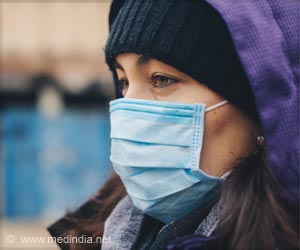To study exactly how wetness impacts droplet penetration, researchers generated mock respiratory droplets using a syringe pump, which slowly pushed liquid through a needle and onto one of three types of mask materials: a surgical mask, and two cloth masks of different thicknesses.
Researchers recorded what happened as the droplets hit the mask using a high-speed camera capturing the impact at 4,000 frames per second, and continued to study it as the mask became damp.
They found that droplets from a cough or sneeze have to be traveling at a higher velocity to be pushed through a mask when wet, compared to when it’s dry.
On hydrophobic masks with low absorptivity, like surgical masks, the respiratory droplets from small beads on the mask’s surface, providing additional resistance for the impacted droplets against possible penetration.
Cloth masks do not exhibit this beading; instead, the cloth absorbs the liquid, with the wetted area spreading as the mask absorbs more volume.
The porous matrix of these cloth masks becomes filled with liquid, and the droplets are therefore required to displace a larger volume of liquid to penetrate the mask. Due to this additional resistance, penetration is weaker.
A previous study detailed the effectiveness of dry masks of one, two, and three layers in stopping respiratory droplets from penetrating the mask.
Using a similar methodology to this wet mask experiment, researchers showed that three-layered surgical masks are most effective at stopping large droplets from a cough or sneeze from getting atomized into smaller droplets.
These large cough droplets can penetrate through the single- and double-layer masks and atomize to much smaller droplets, which is particularly crucial since these smaller aerosol droplets can linger in the air for longer periods.
Source: Medindia



